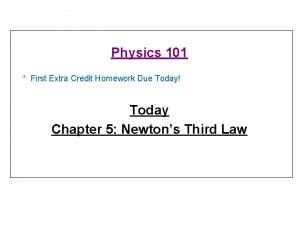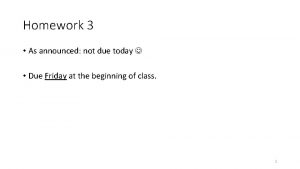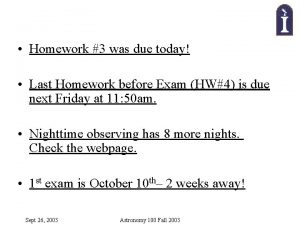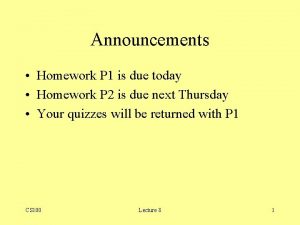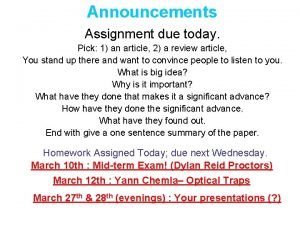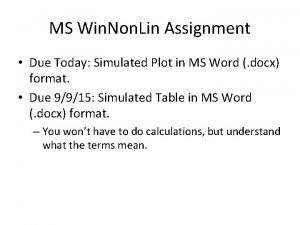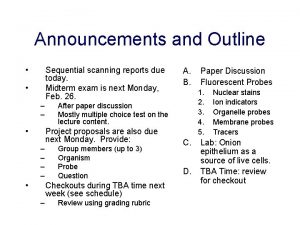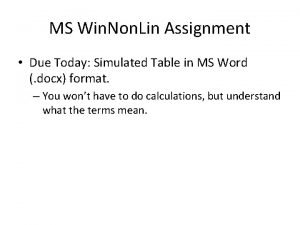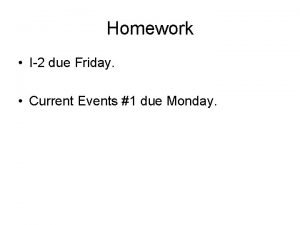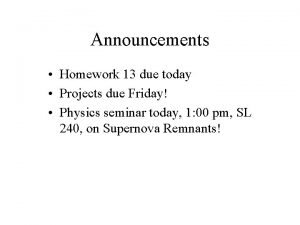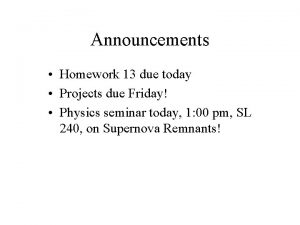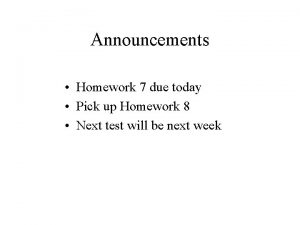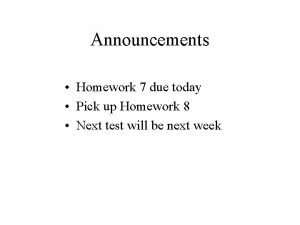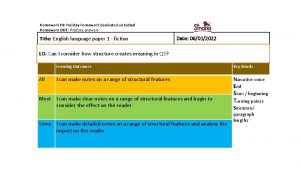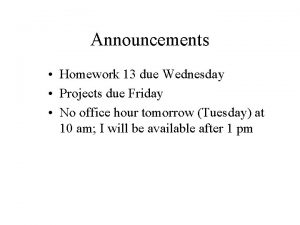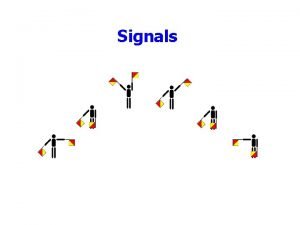Announcements Homework 5 Due today Homework 6 online


![Patterns Given two permutations π of [n] and ρ of [m], we say there Patterns Given two permutations π of [n] and ρ of [m], we say there](https://slidetodoc.com/presentation_image_h2/b0c622eb1938fa2fac4ea25cdadc3c3b/image-3.jpg)



























- Slides: 30

Announcements • Homework 5 Due today • Homework 6 online Due next Friday – Last homework of the quarter!

Last Time • Pattern Avoidance in Permutations
![Patterns Given two permutations π of n and ρ of m we say there Patterns Given two permutations π of [n] and ρ of [m], we say there](https://slidetodoc.com/presentation_image_h2/b0c622eb1938fa2fac4ea25cdadc3c3b/image-3.jpg)
Patterns Given two permutations π of [n] and ρ of [m], we say there is a copy of ρ in π if there are 1 ≤ x 1 < x 2 < … < xm ≤ n so that π(x 1), π(x 2), …, π(xm) have the same relative orders as ρ(1), ρ(2), …, ρ(m). For a permutation ρ, let Sn(ρ) be the set of permutations of [n] that do not have a copy of ρ.

Last Time |Sn(132)|=|Sn(213)|=|Sn(231)|=|Sn(312)|=Cn.

Today • Computing |Sn(123)| – Left to Right minima • Discussion about patterns of length 4+

Final Pattern What about |Sn(123)| = |Sn(321)|? Theorem: For all n, |Sn(123)| = |Sn(132)| = Cn. We will use the following definition: Definition: The Left-to-Right minima of a permutation π are all of the indices i so that π(i) < π(j) for all j < i.

Example X 6 X 5 4 X X 3 X 2 X 1 1 2 3 4 5 6

Left-to-Right Minima We will classify permutations based on the locations (in the permutation graph) of their left-to-right minima. One question is which sets of locations are possible.

Question: Left-to-Right Minima Is it possible to have a permutation where the following are the locations of the left-to-right minima? 6 5 A) Yes B) No X 4 3 X 2 X 1 1 2 3 4 5 6 We would need π(2) and π(3) to both be bigger than 5.

Validity Definition: A set of pairs (i, j) with 1 ≤ i, j ≤ n is valid if: 1) They can be ordered (i 1, j 1), (i 2, j 2), …, (ik, jk) so that i 1 < i 2 < … < ik and j 1 > j 2 > … > jk. 2) For each 1 ≤ a ≤ n, if ilast is the largest of the i’s less than or equal to a, jlast ≤ n+1 -a. Lemma: A set of pairs can be the set of left-toright minima of a permutation of [n] only if it is valid.

Proof Condition (1) must hold since left-to-right minima must be decreasing from left-to-right because they are minima. Condition (2) must hold since π(1), π(2), …, π(a) must all be at least jlast. a

Minima to Permutations Proposition: For every valid set S of pairs, there is exactly one 123 -avoiding permutation and exactly one 132 -avoiding permutation with S as its set of left-to-right minima. This implies that |Sn(123)| and |Sn(132)| are both equal to the number of valid sets of leftto-right minima.

123 -Avoiding Lemma: The non-left-to-right minima in a 123 avoiding permutation are in decreasing order. Proof: Suppose this isn’t the case. • You have (i 1, j 1) and (i 2, j 2) with i 1 < i 2 and j 1 < j 2. • Since (i 1, j 1) not a minimum, there is an (i 0, j 0) with i 0 < i 1 and j 0 < j 1. • Then (i 0, j 0), (i 1, j 1), (i 2, j 2) is a copy of 123.

Picture (i 2, j 2) (i 1, j 1) (i 0, j 0)

123 -Avoiding Therefore, for every valid set, there is exactly one 123 -avoiding permutation with those leftto-right minimums. • Only one since the other terms must come in decreasing order. • Condition (2) implies none of these will be a new minimum. • Lt. R-mins decreasing, others decreasing, therefore cannot have three term increase.

132 -Avoiding We will construct our 132 -avoiding permutation from the left-to-right minima set one step at a time. • We note π(1) will already be one of the left-toright minima. • If π(2) is not a left-to-right minima, we define it. • If π(3) is not a left-to-right minima, we define it.

Example X 6 X 5 X 4 3 X X 2 X 1 1 2 3 4 5 6

Values Lemma: When producing a 132 -avoiding permutation each new value must be the smallest not-yet-used value that is larger than the previous left-to-right minimum.

Proof • Cannot be smaller than previous left-to-right minimum. – otherwise it would be a left-to-right minimum • Cannot be previously used value. • Cannot be a non-minimum value. – Otherwise it, the minimum value (whenever it shows up), and the previous left-to-right minimum will be a 132 pattern.

Non-Minimum Value Filled in values Current Value 3 1 Previous Lt. R min New Value 2 Minimum Unused

This Strategy Works • Condition (2) implies that there is always some minimum value to add. • Always bigger than last Lt. R min • No value can be the ‘ 3’ in a 132 -pattern. – Cannot be a left-to-right minimum – If it’s an element we added: • The ‘ 1’ cannot be smaller than the previous left-to-right minimum • The ‘ 2’ must be an available value between this and the ‘ 3’, but by construction this doesn’t exist.

Proof So, every valid sequence of minimums correspond to: • Exactly one 123 -avoiding permutation • Exactly one 132 -avoiding permutation Thus, |Sn(123)| = #{valid sets} = |Sn(132)| = Cn

Patterns of Length 3 and 4 So for patterns of length 3, things are pretty simple: |Sn(123)|=|Sn(132)|=|Sn(213)|=|Sn(231)| =|Sn(312)|=|Sn(321)|=Cn. For patterns of length 4, things are more complicated: A) There are no longer known explicit formulas B) Not everything is the same

Pattern Comparison Theorem (14. 8): |Sn(1234)| ≤ |Sn(1324)|. Proof: We are going to count the number of permutations with a fixed set of Left-to-Right minima and a fixed set of Right-to-Left maxima. Rt. L maxima Ev er Lt. R minima yt hin ge lse

1234 Lemma: For a 1234 -avoiding permutation, the “everything else” must be sorted in decreasing order. Proof: Suppose not. • Unsorted pair • Smaller Lt. R min • Larger Rt. L max • 1234 pattern

1324 Lemma: For every set of left-to-right minima and right-to-left maxima that admits some permutation, there is at least one consistent 1324 -avoiding permutation. Proof: If all other elements were increasing, we would be OK. Not always possible.

Idea Start with any permutation. If not 1324 avoiding, make it closer. If have 1324, make replacement. Not Lt. R min nor Rt. L max.

Why Does This Work? • Each step makes the “everything else” points closer to being sorted. – For example, increases sum of i*j over all pairs (i, j) – Therefore, must eventually terminate • Once it terminates you have a 1324 -avoiding permutation with the original sets of minima/maxima.

Proof of Result • Each sequence of left-to-right minima and right-to-left maxima that admits a permutation has: – At most 1 corresponding 1234 -avoiding permutation – At least 1 corresponding 1324 -avoiding permutation. Therefore, |Sn(1234)| ≤ #{min/max patterns} ≤ |Sn(1324)|.

Strictness Note: For n ≥ 7 inequality is strict. Need to show two 1324 -avoiding perms with same min/max sequences. 7 7 6 6 5 5 4 3 2 1
 Folk culture and popular culture venn diagram
Folk culture and popular culture venn diagram Black cat analogy
Black cat analogy Homework due today
Homework due today Homework due today
Homework due today Homework due today
Homework due today Homework due today
Homework due today Homework due today
Homework due today Pvu background
Pvu background R/announcements!
R/announcements! Church announcements
Church announcements What two announcements did montag hear
What two announcements did montag hear Kayl announcements
Kayl announcements General announcements
General announcements Today meeting or today's meeting
Today meeting or today's meeting Are we having class today
Are we having class today Today meeting or today's meeting
Today meeting or today's meeting Galton details
Galton details Today's lesson or today lesson
Today's lesson or today lesson Example of repitition
Example of repitition Assignment due today
Assignment due today Assignment due today
Assignment due today Assignment due today
Assignment due today Reports due today!
Reports due today! Blood supply of liver
Blood supply of liver Astr 100 uiuc
Astr 100 uiuc Quattro lati
Quattro lati Procedural vs substantive due process
Procedural vs substantive due process Slidetodoc. com
Slidetodoc. com Due piccole sfere identiche sono sospese a due punti
Due piccole sfere identiche sono sospese a due punti I blank finish my homework last night
I blank finish my homework last night Homework is due on friday
Homework is due on friday


